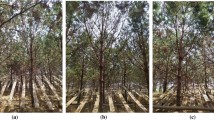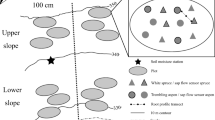Summary
The relationships between volumetric soil water content (ϕ), in situ soil water potential (Ίsoil) and predawn xylem pressure potential (Ίpredawn) were quantified in four contrasting lodgepole pine ecosystems in Wyoming, USA. On three of the sites, changes in Ίsoil correlated closely with Ίpredawn, but on a porous soil derived from coarse granitic parent material, Ίpredawn declines occurred much sooner than corresponding declines in Ίsoil, possibly because of local depletion of rhizosphere moisture and low molecular diffusivity of water in that soil. Exptrapolation of laboratory-derived characteristic curves for soil moisture to field conditions yielded different relationships between ϕ and Ίsoil than curves derived from in situ measurements, probably because of disruption of soil structure and porosity during sample collection and handling in laboratory studies. Although a close correlation between ϕ and Ίpredawn was observed, future efforts at modelling the soil-plant-atmosphere continuum should be directed towards a more detailed understanding of the complex relationships between Ίsoil at varying depths and plant water stress.
Similar content being viewed by others
References
Black CA (ed) (1965) Methods of soil analysis. Part I: Physical and mineralogical properties including statistics of measurement and sampling. Amer Soc Agron, Madison, Wisconsin
Brady NC (1974) The nature and properties of soils. 8th ed. MacMillan Publ Co Inc, New York
Fetcher N (1976) Patterns of leaf resistance to lodgepole pine transpiration in Wyoming. Ecology 57:339–345
Hillel D (1971) Soils and Water. Academic Press, New York
Hinckley TM, Lassoie JP, Running SW (1978) Temporal and spatial variation in the water status of forest trees. For Sci Monogr 20, p 72
Knight DH, Fahey TJ, Running SW. Water and nutrient outflow from contrasting lodgepole pine forests in Wyoming. Ecological Monographs, in press
Kramer PJ (1949) Plant and soil water relationships. McGraw-Hill, New York
Lassoie JP (1982) Physiological activity in Douglas-fir. In: Edmonds RL (ed) Analysis of coniferous forest ecosystem in the western United States. US/IBP Synthesis Series 14, Hutchinson Ross Publishing co, Stroudsburg, PA, pp 126–185
Lopushinsky W (1975) Water relations and photosynthesis in logepole pine. In: Baumgartner DM (ed) Management of lodgepole pine ecosystems. Vol 1, Coop Ext Serv, Coll Agri, Washington State Univ, Pullman, WA pp 135–153
Neter J, Wasserman W (1974) Applied linear statistical models. Richard D Irwin Inc, Homewood, Illinois
Pearson J, Fahey TJ, Knight DH. Biomass and leaf area of lodgepole pine forests in southeastern Wyoming. Canadian Jounal of Forest Research, in press
Richter H (1973) Frictional potential losses and total water potential in plants: a re-evaluation. J Exp Bot 24:983–994
Ritchie GA, Hinckley TM (1975) The pressure chamber as an instrument for ecological research. Adv Ecol Res 9:164–254
Running SW (1976) Environmental control of leaf water conductance in conifers. Can J For Res 6:104–112
Running SW (1980) Environmental and physiological control of water flux through Pinus contorta. Can J For Res 10:82–91
Running SW, Waring RH, Rydell RA (1975) Physiological control of water flux in conifers: A simulation model. Oecologia (Berlin) 18:1–16
Running SW, Knight DH, Fahey TJ (1982) Description and application of H2O TRANS., a stand-level hydrologic model for western coniferous forests. In: Third International Conference on State-of-the-Art in Ecological Modelling, Colorado State University, Fort Collins, CO, 24–28 May 1982
Salisbury FB, Ross CW (1978) Plant pathology 2nd ed. Wadsworth Publishing Co, Inc, Belmont, CA
Scholander PF, Hammel HT, Bradstreet ED, Hemmingsen EA (1965) Sap pressure in vascular plants. Science 143:339–346
Slatyer RO (1967) Plant water relationships. Academic Press, London
Soil Survey Staff (1975) Soil taxonomy, a basic system of soil classification for making and interpreting soil surveys. Agric Handbook Number 436, USGovernment Printing Office, Washington, DC
Tan GS, Black TA (1976) Factors affecting the canopy resistance of a Douglas-fir forest. Boundary-Layer Met 10:475–488
Van Keulen H (1975) Simulation of water use and herbage growth in arid regions. Centre for Agricultural Publishing and Documentation, Wageningen
Waring RH, Cleary BD (1967) Plant moisture strees: Evaluation by pressure bomb. Science 115:1248–1254
Author information
Authors and Affiliations
Rights and permissions
About this article
Cite this article
Fahey, T.J., Young, D.R. Soil and xylem water potential and soil water content in contrasting Pinus contorta ecosystems, Southeastern Wyoming, USA. Oecologia 61, 346–351 (1984). https://doi.org/10.1007/BF00379633
Received:
Issue Date:
DOI: https://doi.org/10.1007/BF00379633




